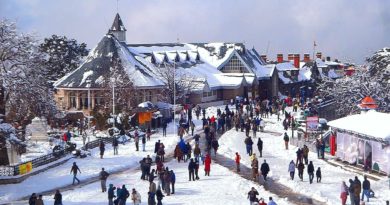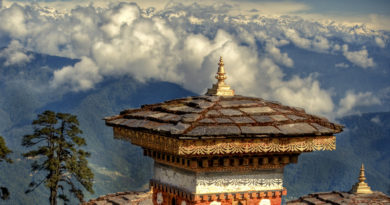Best Places To Visit In September In India
We all look forward to little breaks, that can refresh us and allow us to revitalize our mind body and soul. If you are looking to take a small vacation in September, then you can explore our list given below:
Khandala: Khandala is a popular weekend destination for people staying in Mumbai, it’s just three hours drive away from the financial capital of the city. The city is located 625 mts above the sea level on the Western slopes of the Sahyadri mountain range. Hotels in Khandala are always full with people looking to spend time amidst serene and green surroundings.While staying in hotels in Khandala one can visit popular sites like: Rajmachi Park, Duke’s Nose, Kune Falls, Monkey Hill, Reversing Station, Tiger’s Leap, Tungarli Lake, Lonavala Lake and Bhushi Lake and Bhusi Dam also known as the Walvan Dam. Khandala offers several trekking sites, hotels in Khandala are full with tourists who are looking to trek on small slopes and trails. Khandala is a popular vacationing site for people staying in Mumbai or people visiting the city. The city sees a spurge in tourist numbers in monsoons as the lakes and waterfalls have abundant water in them.
Kumarakom: Tucked away on the backwaters of Kerala, a vibrant and living network of canals, estuaries and lakes, is a quaint little village called Kumarakom. It is a timeless world where one can luxuriated in the gentle pace of unhurried activity. Here, where the land celebrates the bounty of nature with a riot of vegetation, one may leave the world of strife behind, go fishing with a simple rod and line, admire the grace of local fishermen as they cast their nets with the elegance of dancers… Out on the waters of the Lake Vembanad country crafts, some sporting patchwork sails that balloon in the wind, cruise by. What makes Kumarakom special is that despite the fact that it has a number of 5-star luxury resorts and hotels it still retains its unsullied beauty.
Sravanabelagola: One can see Lord Bahubali’s statue much before one reaches his holy abode some 157 km from Bangalore, Karnataka. Yes, you will be able to see the 17.2 metre statue of the Jain saint towering head and shoulders above the rocky outcrop on which it stands miles outside the pilgrim town. Getting to the foot of the statue, however, can prove to be a daunting task for not only does one have to climb up 614 steps cut into a 470 ft high rock but the sun-warmed stairway scorches one’s bare feet. As you trudge up the hillock, you will go past little shrines, many pillared temples and the blushing bloom of gulmuhor trees which had somehow managed to drop roots in this rocky terrain before reaching your final destination. Here in the open courtyard of a temple is the world’s largest freestanding, monolithic statue. Carved out of a single block of fine-grained, dove-grey granite rock in 981 AD, this amazing statue is unmarked even after being exposed to the elements for centuries. Only the forefinger in the left hand is shorter than it should be. But that is by design: to ward off the evil eye. And they say that in the moonlight it glows white against a star-speckled night sky. The town has a number of Jain temples or bastis and monasteries like Bhandari and Akkana Basti, 525 inscriptions and a cave on the smaller hill facing the monolith in which the saintly monk Chandrababu lived in 3 BC.
Tarkali: Although famous for its beach, undoubtedly one of the finest on the West Coast of India, which lies between Mumbai and Goa, tourists often miss the spectacular sea fort of Sindhudurg soared out of the wrinkled waters like a ghostly galleon. Built in 1664 by Chhartapati Shivaji, the fort was earmarked to become the headquarters of the Maratha navy. This island citadel was originally earmarked to become the naval headquarters of the Marathas. However, it never did achieve the honour.
Hyderabad: The legacy of the old order still lingers in the palaces and monuments sprinkled across the city. The Charminar, for instance, steeped in romance and history. Not far from this iconic monument is the Salar Jung Museum that epitomizes the spirit of Hyerabadi nobility. The museum houses over 35,000 objets d’ art, all part of the private collection of one single man, Navab Salar Jung III who served as Prime Minister of the Nizam. Delicate Chinese porcelain, carved Louis XV furniture, jade hilt daggers and swards that belonged to Mughul emperors and their queens, bronze and marble sculptures, intricate ivory carvings, miniature paintings and the works of European masters, an endless collection of chandeliers and artefacts’ and priceless treasures from all over the world are a living testimony of the man’s artistic taste and enormous wealth.
Nagaland is one the most beautiful places in India as it is still undisturbed by mass tourism. This state is the farthest lying state in northeast and has unparallel natural beauty and cultural heritage. Tourists need to carry special Inner Line Permits (relatively easy to obtain) to enter Nagaland. Once when you interact with the local you will know the portrait of the Nagas: ancient and hardy as the hills around them yet tempered with the gentleness of earthy innocence.
Mussoorie: set in the lavender tumble of the Shivaliks, is a lively colonial cameo. Bejewelled brides in rustling silks and suited grooms strut up and down the mall, gaze at the muscled Shivaliks and the snow kissed Himalayas beyond. Some bounce on horses on Camel’s Back Road or in cycle rickshaws. The city is a walker’s place where one can stumble on urbanized areas and even the untrammelled. One can trek to the various water falls like Mossey Fall, Bhatta Fall and Jharipani Fall; or head for the Sir George Everest House where the first surveyor general of India after whom the highest peak in the world has been named lived; or check out Clouds End, now a hotel, which was built in 1838, and was one of the first four bungalows in Mussoorie.


